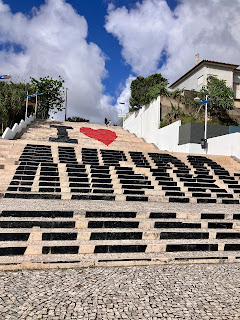So off we set on foot to climb up (about a 2 km walk): the most wonderful views along the way. It is a gorgeous morning which is a blessing as there is rain predicted today.
What a different experience today up top from when we came on our tour with Alberto: hardly anyone around. We walked to the fort and looked out over the northern beach and the Atlantic Ocean which is where the famous 30 m waves occur - generally in August when surfers from around the world descend on the town.
The Legend of Nazaré is that in 1182, D. Fuas Roupinho, mayor of the castle of Porto de Mós, was hunting along the coast when he saw a deer that immediately started chasing. D. Fuas, in the fog, realised that he was on the edge of the cliff, but that he was right next to a cave where an image of the Virgin Mary with the Child Jesus was venerated. He cried out for help and the horse miraculously stopped thus saving D. Fuas from certain death. In memory of the miracle, he had the Hermitage of Memory built and King D. Fernando in 1377 - due to the significant influx of pilgrims - ordered the construction of a church, near the chapel. Even the explorer Vasco da Gama came on a pilgrimage to Sítio da Nazaré.
In the early 2000s, word started spreading among surfers that Nazaré was home to monster waves (thanks to a large underwater canyon just off the Portuguese coast). Daredevil surfers started flocking to the town and, in no time, surfing records were broken.
To combine the legendary origins of Nazaré and its recent crowning as a world-class surfing destination, Agostinho Pires and Adália Alberto collaborated to create the statue known as Veado. It’s a 6.3 m statue of a human figure with the head of a deer, holding a surfboard; it stands tall on the road to the lighthouse.
We enjoy a coffee and pastry opposite the church, completely unencumbered by crowds. Peaceful, relaxing, lovely.
There are women here who have stalls selling fruit, nuts and what-nots. They wear the traditional dress of skirts made bulky with seven petticoats. In the old days, women would wait on the beach for fishermen to sail home. To keep warm in the face of a cold sea wind, they would wear several petticoats. The ensemble is completed with house slippers, an apron (hand-embroidered by the wearer), a woollen cape, head scarf and flamboyant jewellery, including chunky gold earrings (often passed down from generation to generation).
We walk back down to our apartment enjoying the views. Breakfast, shower, etc. - then off to the bus station (which fortunately we had walked to enroute earlier today so we knew where it was - an advantage when towing suitcases - and over broken cobbled footpaths!).
We travel north towards Porto, stopping at Aveiro - due in about 1:30 pm.
It took a while to find our hotel lugging our suitcases along - quite a walk - and steps (argh!!).
Fortunately our room was ready so we could quickly change and walk to the bike shop to pick up our pre-arranged rentals for the afternoon. Sadly it started to rain and it was certainly a cold wet ride to the Praia da Costa Nova. Mind you, when we made one mis-turn, we came across a flock of flamingos feeding in the lagoon!
Costa Nova lies on a narrow sandbar peninsula that shelters the Ria de Aveiro (Aveiro lagoon). It is no doubt a delightful village (when it isn’t raining …) famed for its magnificent sandy coastline and colourful beach houses painted in traditional striped patterns. Sadly I only saw one briefly through my misted up glasses - we headed for a cafe on the beach to seek shelter and have a toasted sandwich and coffee to warm up. Great views out to the Atlantic Ocean and the waves pounding the beach.
Finally just after 5 pm the sun came out and we had a gorgeous afternoon cycling back to Aveiro and exploring the city.
Aveiro is a city in the Centro Region of Portugal which has a network of water channels through which moliceiros (local boats) travel. Very picturesque, especially at night.
We enjoyed our walk home from dinner along the pretty paved streets. Walked 19 kms, cycled 30 kms.














No comments:
Post a Comment